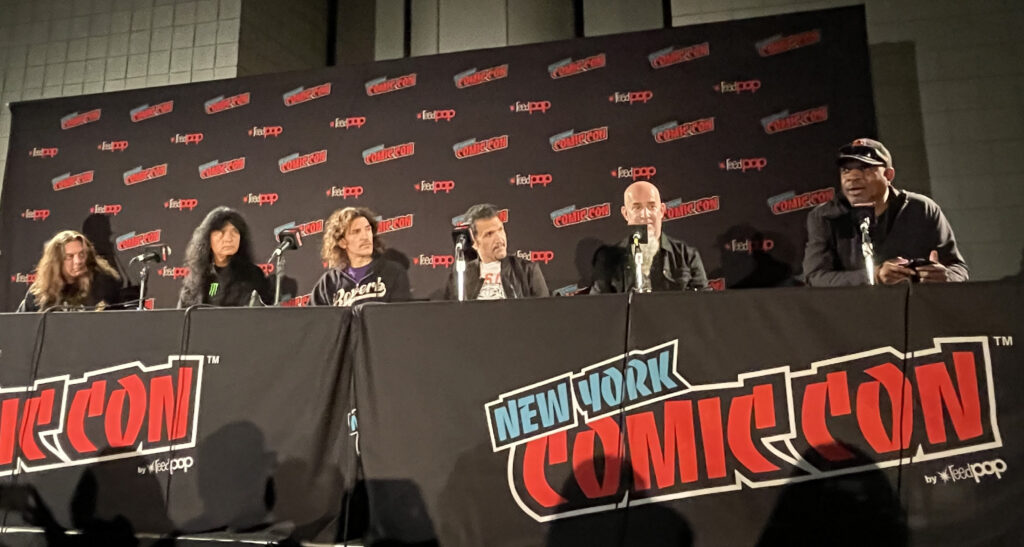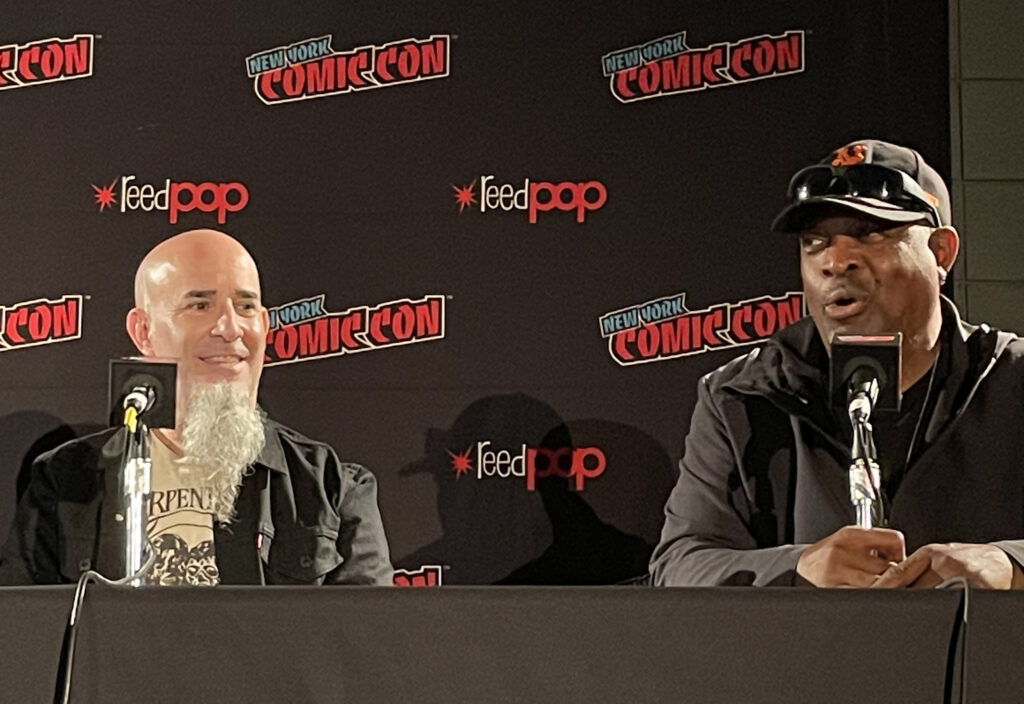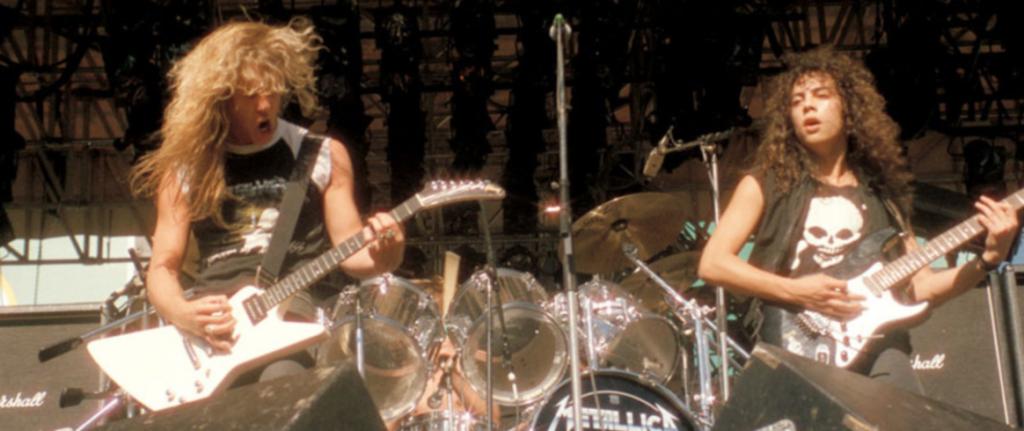October 9, 2021
by Carla Hay

In 1991, heavy metal band Anthrax and rap group Public Enemy (both New York-based acts) released their groundbreaking single “Bring the Noise,” which helped usher in and influence a musical movement of artists blending hard rock/heavy metal and rap. Artists such as Korn, Linkin Park, Limp Bizkit and Kid Rock (in his early career) owe a lot to how “Bring the Noise” laid the groundwork for the rap/heavy metal hybrid. The Anthrax/Public Enemy version of “Bring the Noise” was a remake of Public Enemy’s 1988 song “Bring the Noise.” Aerosmith and Run-DMC’s 1986 hit “Walk This Way” (which was a cover version of Aerosmith’s 1975 hit “Walk This Way”) was also an influence in merging rap and rock, but “Walk This Way” was more pop-leaning hard rock than heavy metal.
To celebrate the 30th anniversary of “Bring the Noise,” Public Enemy leader Chuck D and the current members of Anthrax did a panel discussion together at the 2021 edition of New York Comic Con, held at the Jacob K. Javits Convention Center in New York City. Chuck D and members of Anthrax are also comic book enthusiasts and have collaborated with Z2 Comics to release graphic novels. Anthrax’s graphic novel “Among the Living” (named after the band’s 1987 album) was released in July 2021. Chuck D worked with Z2 Comics on the graphic novel “Apocalypse 91: The Revolution Never Sleeps” (released in June 2021), inspired by Public Enemy’s 1991 album “Apocalypse 91… The Enemy Strikes Black.”
Chuck D, Anthrax rhythm guitarist Scott Ian, Anthrax lead singer Joey Belladonna, Anthrax bass player Frank Bello, Anthrax drummer Charlie Benante and Anthrax lead guitarist Jonathan Donias gathered for a lively panel discussion at New York Comic Con. After the panel discussion, Anthrax and Chuck D headed over the Z2 Comics booth in exhibition area, where they signed autographs (Anthrax signed copies of the “Among the Living”), posed for fan photos and took questions from fans. Here are some of the highlights from the Anthrax/Chuck D panel discussion.

How and when did you get into comics?
Chuck D: I was born in 1960. So when Marvel started, it was the first thing I recognized, along with all the superheroes of DC [Comics]. Back when I was growing up, it was DC and Marvel. When I was in first grade in 1966, the amazing thing was Marvel had quasi-animation on [television] … I remember they had Captain America, the Hulk, Iron Man, Thor and Spider-Man. Comics were 12 cents [back then]. I was like, “Wow,” this matches up with the television [shows]. It was a great beginning.
I actually competed and drew my own comic books, but I also bought comic books. I didn’t front on Superman. He wasn’t corny. He was on TV. And then Batman came out on TV in 1966—Adam West and those dudes.
And then, the thing that really bit me, it wasn’t a comic, but “Star Trek” came out in 1967. I was 7, going on 8. That was really something. Those were the things that kind of took my imagination to the next realm.
I was growing up as a black kid in Queens. At the same time, you had Dr. Martin Luther King and Malcolm X. All that was going on with real people. It was also in that swirl that you could dare to dream and imagine. Muhammad Ali, he went from Cassius Clay to Muhammad Ali, so he took on a superhero name.
Scott Ian: I still remember all the theme songs from those Marvel shows … My son knows those songs too … For me, it was similar to Chuck. [We’re] almost the same age. Growing up in Queens, I had an uncle who was 10 years older than me. When I would go over to his house, I would rifle through [his comic books].
Even before I could read, I would just sit there and look at the pictures of the Fantastic Four and Thor and Conan [the Barbarian]. That’s basically the first stuff I ever read was comic books. I credit [Marvel Comics iconic writer] Stan Lee with teaching me how to read. I was a card-carrying member on the Merry Marvel Marching Society in the 1960s … Comics is the most constant thing from the earliest age of my life.
Charlie Benante: I was on the opposite side. I was drawing the comics instead of reading them. I couldn’t wait to get the latest Hulk comic or Spider-Man comic, and learn how to draw from them. That art, that was inspiring to me. That’s all I cared about back then.
Like Chuck said about the TV shows, it was such a great thing to see them [the comic book characters] moving. The music in those shows was so awesome. Everything was great about those days.
Frank Bello: Growing up in the same household as Charlie [Editor’s note: Bello is Benante’s nephew] and watching him—I’m going to kiss his ass right now—I don’t know if you guys know this, but he’s a great artist. He does most of our artwork.
Growing up in that house and seeing the talent he had—this was even before music—just watching it got me into it. And, of course, the [TV] shows, they were great. I love that stuff. That’s a fantasy world we all need. It’s still important today.
Benante: It’s crazy how Judge Dredd came into the mix of music and comics. Scott would take if from there. Judge Dredd was such an amazing figure, to write about him. I remember the first time we played England, it was so huge. People were like “This is the greatest thing you guys have done.”
Ian: [He says jokingly] It was all planned … I was a huge Judge Dredd fan. I just remember hearing for the first time, Charlie had these riffs that became the [Anthrax] song “I Am the Law” [from the “Among the Living” album]. It sounded like a superhero theme song. It just clicked in my head.
Joey Belladonna: I like the [comic book] art. I’m with Charlie on the art. I got lucky. I moved Scott’s comics from one of his apartments. That was a lot of work. I couldn’t believe how heavy those boxes were.
Jonathan Donias: I’ve got to be honest. I don’t know much about comics. I had a Guns N’Roses comic as a kid.
How did your collaboration with Z2 Comics come together?
Benante: We tried to do a comic book for years. I always say that the last couple of [Anthrax] album covers were telling a story … And then COVID-19 hit. Josh [Frankel, publisher/owner of Z2 Comics] contacted us and said it would be a great idea to do a comic about the “Among the Living” album, but don’t take the songs the way that they were written on the record. Let people write their own story around the title. I was so excited about that. And everybody else was like, “Let’s do this.”
Ian: Yeah, we’d been asked to do a comic forever. And we’d always say no, because it’s always cheesy. They want to turn us into superheroes. I never want it to be us in the comic book. Anything we ever saw, or anything we were ever pitched [before Z2 Comics], was terrible. As someone who is a fan of that world, I just want it to be good.
When that idea was pitched to us: What if we have different writers take a song and see how it feels to them see what they take from that song? I was like, “Okay, I really like that idea, but here’s the wish list of people. Because if we can’t get the people we want, I still won’t want to do it, because I’m not writing it.” The first name on the list was Grant Morrison. I figured, “We’ll aim high.” And Grant said yes.


